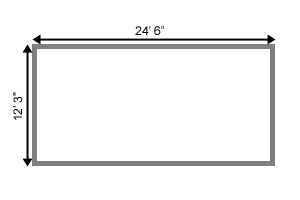
Posters are located chiefly in commercial and industrial areas on major local roads. They are viewed principally by people in automobiles or pedestrians and deliver exposure to residents and to commuter traffic.
PRIMARY USES
This format is often used as a full market coverage medium for reach and frequency. Packaged buys can be tailored for specific marketing goals: supermarket coverage, ethnic targeting, focus on certain geographic areas, etc.
AVAILABILITY
Posters can be found in virtually all markets (cities/towns) except those in Alaska, Hawaii, Maine, and Vermont.
RESEARCH/MARKET INFORMATION
TAB OOH Ratings are the official measurement system. Reach and frequency can be calculated using several accepted media software programs.
Method of Purchase
Posters are purchased in GRP programs of different weights, typically in four to 52-week units, depending on campaign objectives.
SPECIFICATIONS

The total area for posters is 125” x 272”.
Design
Efficient creative design is critical for visual impact. A simple design with few words provides the best impact for reaching the targeted audience.
PRODUCTION
Substrates
Lightweight and recyclable PE (polyethylene) and PP (polypropylene) thermo-plastic materials, and sometimes lightweight PVC, are installed as single sheet posters onto structures without the use of adhesive paste. Posters made from these materials are available from many printers. Single sheet posters provide a seamless appearance, prevent flagging, and reduce weather delays when posting campaigns.
In some markets, paper posters are still accepted.
Installation Systems
Single sheet posters are mounted using various cable and clip installation systems. Confirm which installation systems are used by individual OOH media companies.
Exposure Time
Panels should be reposted every 60-90 days.
Mechanicals
Finished art should be scaled 1” to 1’.
Delivery
Deliver posters to out of home companies 10 working days prior to posting date.
Published: September 12, 2022